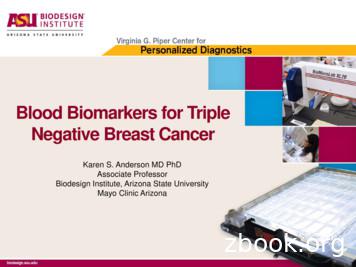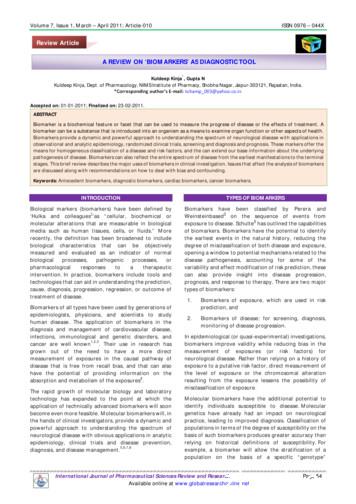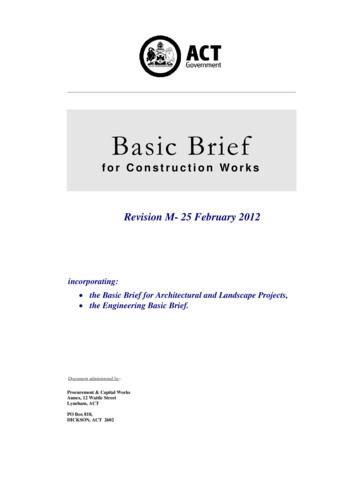Brief Overview Of Biomarkers: Value, Limitations, And The Biomarker .
Brief overview of biomarkers: value,limitations, and the BiomarkerQualification Program (BQP)Peter Stein, MDDeputy DirectorOffice of New Drugs / CDER / FDA
Disclaimers Views expressed in this presentation arethose of the speaker and do not necessarilyrepresent an official FDA position I do not have any financial disclosuresregarding pharmaceutical drug products 2
Overview Types of biomarkers – a brief review Surrogate endpoints – value and limitations Challenges of biomarker development3
BEST Resource: Biomarkers, EndpointS, andOther Tools A glossary of terminology and uses of biomarkersand endpoints in basic biomedical research,medical product development, and clinical care Created by the NIH-FDA Biomarker Working Group Publicly available athttp://www.ncbi.nlm.nih.gov/books/NBK326791/ BEST harmonizes terms and definitions andaddresses nuances of usage and interpretationamong various stakeholders, including: Biomedicalscientists BiomedicalscientistsTranslationaland Translationalandclinicalclinical researchersresearchers MedicalproductdevelopersdevelopersMedicalproduct Patient/disease advocacy groupsPatient/diseaseadvocacy groups Government officialsGovernmentofficials CliniciansClinicians4
Biomarker: definition“A defined characteristic that is measured as anindicator of normal biological processes,pathogenic processes, or responses to anexposure or intervention, including therapeuticinterventions. Molecular, histologic, radiographic,or physiologic characteristics are types ofbiomarkers.”5
Why develop biomarkers? High quality biomarkers can markedly accelerate and enabledrug development in areas of unmet need Biomarkers can improve trial efficiency and feasibility– Improve ease and accuracy of identifying patient population– Enrich the study population Study population with more events – so detecting change in outcomewith treatment becomes feasible Study a more responsive study population to detect a drug effect– Improved monitoring Enhanced patient safety – earlier detection of drug toxicity Detect changes in patient status– Improve assessment of treatment response; predict clinical benefit Address unmet medical needs, where progress is halted ordelayed by lack of adequate drug development tools,including biomarkers6
BEST (Biomarkers, EndpointS, and other Tools)Classification: Range of Biomarker Types Susceptibility / risk biomarker Diagnostic biomarker Prognostic biomarkerMeasures of diseasepresence and status Monitoring biomarker Predictive biomarker Pharmacodynamic/Responsebiomarker – including surrogateendpointsMeasure aspects of responseto treatment Safety biomarker7
Disease-Focused BiomarkersNon-disease populationSusceptibility or risk predictor biomarkersIndividuals at high risk of disease orpre-clinical disease populationDiagnostic biomarkerDiagnostic biomarkerPatients with diseaseDiagnosticbiomarkerDiseaseSubtype 1DiseaseSubtype 2
Disease-Focused BiomarkersNon-disease populationSusceptibility or risk predictor biomarkersIndividuals at high risk of disease orpre-clinical disease populationDiagnostic biomarkerDiagnostic biomarkerPatients with diseaseDiagnosticbiomarkerDiseaseSubtype 1DiseaseSubtype 2Prognostic biomarkerPrognosticbiomarkerPatients with disease at higher risk ofdisease-related outcome(s)
Disease-Focused BiomarkersNon-disease populationSusceptibility or risk predictor biomarkersIndividuals at high risk of disease orpre-clinical disease populationDiagnostic biomarkerDiagnostic biomarkerPatients with diseaseDiagnosticbiomarkerDiseaseSubtype 1DiseaseSubtype 2Prognostic biomarkerPrognosticbiomarkerPatients with disease at higher risk ofdisease-related outcome(s)Diagnostic biomarkerDisease-related outcome(s)
Disease-Focused BiomarkersNon-disease populationSusceptibility or risk predictor biomarkersMonitoring biomarker: assess disease statusIndividuals at high risk of disease orpre-clinical disease populationDiagnostic biomarkerDiagnostic biomarkerPatients with diseaseDiagnosticbiomarkerDiseaseSubtype 1DiseaseSubtype 2Prognostic biomarkerPrognosticbiomarkerPatients with disease at higher risk ofdisease-related outcome(s)Diagnostic biomarkerDisease-related outcome(s)
BEST (Biomarkers, EndpointS, and other Tools)Classification: Disease Focused Biomarkers Susceptibility / riskbiomarker: Diagnostic biomarker: Monitoring biomarker: Prognostic biomarker:Examples: BMI or 2 hr post-meal glucose for diabetes risk Apo E genotype risk for Alzheimer’s diseaseKey uses: Define population for more efficient preventiontrialsExamples: Blood pressure in hypertension FEV1 for COPDKey uses: Define disease population for studyExamples: HCV-RNA PSA in prostate cancerKey uses: Monitor patient status in trialsExamples: Gleason score in prostate cancer Total kidney volume in AD-PCKDKey uses: Define higher risk disease population, enhancing12trial efficiency
Treatment-Related BiomarkersPatients with diseasePredictive biomarkerLower ornon-responderpopulationResponder or higher responder population
Treatment-Related BiomarkersPatients with diseasePredictive biomarkerLower ornon-responderpopulationResponder or higher responder populationDrugTreatmentPhase 1, 2a (early stage biomarkers)Target engagementbiomarkerDrug is hitting targetPharmacodynamic/Response BiomarkersPharmacodynamicbiomarkerRelevant pathway is modulatedProof of PharmacologyProof of Concept
Treatment-Related BiomarkersPatients with diseasePredictive biomarkerLower ornon-responderpopulationResponder or higher responder populationDrug TreatmentPhase 1, 2a (early stage biomarkers)Target engagementbiomarkerDrug is hitting targetPharmacodynamic/Response BiomarkersPharmacodynamicbiomarkerRelevant pathway is modulatedProof of PharmacologyProof of ConceptPhase 2b, 3 (later stage biomarkers)Reasonably likelysurrogate endpointEndpoint likely to predictoutcome or clinical benefit (AA)Validatedsurrogate endpointEndpoint predicting outcome orclinical benefit (Full Approval)Intermediateclinical endpointEarlier change in definitiveendpoint (Accel Approval, AA) Disease morbidity / mortality (“survives”) Clinical benefit (“feels or functions”)Surrogate EndpointsClinicalOutcomes
Treatment-Related BiomarkersPredictive biomarkerLower ornon-responderpopulationResponder or higher responder populationPhase 1, 2a (early stage biomarkers)Drug TreatmentSafety biomarkers: assess treatment-related toxicityPatients with diseaseTarget engagementbiomarkerDrug is hitting targetPharmacodynamic/Response BiomarkersPharmacodynamicbiomarkerRelevant pathway is modulatedProof of PharmacologyProof of ConceptPhase 2b, 3 (later stage biomarkers)Reasonably likelysurrogate endpointEndpoint likely to predictoutcome or clinical benefit (AA)Validatedsurrogate endpointEndpoint predicting outcome orclinical benefit (Full Approval)Intermediateclinical endpointEarlier change in definitiveendpoint (accelerated approval) Disease morbidity / mortality (“survives”) Clinical benefit (“feels or functions”)Surrogate EndpointsClinicalOutcomes
BEST (Biomarkers, EndpointS, and other Tools)Classification: Treatment-focused biomarkers Predictivebiomarker:Examples: Cystic fibrosis genotypes response to ivacaftor Microsatellite-high predicts response to pembrolizumabKey uses: Trial enrichment – improves efficiency, reduces samplesize, increases response to treatment Pharmacodynamic/Responsebiomarker:Examples: Blood pressure in hypertension FEV1 or 6 minute walk test LDL-CKey uses: Demonstrating drug-target engagement, dose-ranging Surrogate endpoints (validated or reasonably-likely) Safety biomarker:Examples: ALT, creatinine / eGFR Urinary kidney injury biomarkers (KIM-1, etc.)Key uses: Detecting / assessing drug toxicity17
BEST (Biomarkers, EndpointS, and other Tools)Classification: Pharmacodynamic / Response BMsTo support approval, FDA expects substantial evidence ofeffectiveness – that shows that a drug improves meaningful clinicaloutcomes: how a patient feels, functions, or survives A validated surrogate endpoint: accepted by FDA that the effecton the biomarker predicts a specific clinical outcome. Validatedendpoints have strong and diverse evidence supporting therelationship of the BM and the outcome A “reasonably likely” surrogate endpoint: an endpointsupported by strong mechanistic and/or epidemiologic rationalesuch that an effect on the surrogate endpoint is expected to becorrelated with a clinical benefit, but not yet reaching thestandard for validation.18
Types of Surrogate EndpointsCausal BiomarkerPathway or mediatorbiomarkerReflecting causal factorIn pathway of disease:mediator of damage Genetic or geneticrelated defectivefunction (e.g., genevariant, decreasedenzyme level orfunction) Environmentalexposure (e.g., bloodlead level, etc.) Microbiologic (e.g.,HIV, HCV, bacterialculture, AFB smear)BADCEOrgan injurybiomarkerSites of InjuryReflecting organinjuryOrgan 1ClinicalfunctionEvent orfunctional lossClinicalFunctionalMeasuresOrgan 2Organ 3Tissueinjury BMOrganFunctionBMClinicalEvents19
The limitations of surrogate endpoints Not a direct measure of how a patient feels, functions orsurvives Intended to reflect and predict clinical benefit not measure theoutcome With a surrogate endpoint, the benefit / risk assessmenttherefore must be based upon assumptions / predictions ofbenefit– Translating the extent of clinical benefit from an indirect measure, andalso using a limited dataset on risk to assess harms– Challenging when a drug shows clear effects on a surrogate endpoint –but also has safety issues And biomarkers may fail to predict clinical benefit20
The limitations of surrogate endpointsSurrogate on causal pathwaymodulated by drugSurrogate not on causal pathway bywhich drug leads to benefit, ormultiple pathways of leading toclinical outcome, BM may or maynot reflect key pathwaysDrug may induce adverse effects ondesired clinical outcome through apathway not reflected by BM, or maylead to other toxicities BM doesnot reflect benefit (or cityClinicalOutcomeAfter Fleming Statistics in Medicine 201221
Biomarker integration into drugdevelopment: 3 pathways IND pathway: based upon agreement with the division, inthe context of a specific drug development program Scientific community consensus: broadly/widely usedbiomarker, appropriate scientific support, generallyaccepted by experts in the field Biomarker qualification program: review and acceptancebased upon appropriate submission qualification package;available for use in any development program withinapproved context of use22
The challenges of biomarker development Many disease areas with unmet needs have insufficient drug developmenttools to maximize trial efficiency (or even feasibility) Biomarker development is a long and resource-intensive task– Biomarker discovery: biased or unbiased screening in animal, clinical, epidemiological(include RWE)– Early animal translational models– Clinical or epidemiology observational studies– Analytic validation efforts: assure accuracy / reproducibility of measure– Interventional studies with “gold standard” endpoints compared to candidate – withmultiple different treatments (different MOAs) to show that BM works across drugclasses Many stakeholders in the mix:– Academic investigators at multiple institutions, US and ex-US– Often several academic societies in disease area with different viewpoints andmembership– Different companies – both drug and device-focused may be working in the area– May be different patient stakeholder organizations The challenge: how to prioritize biomarker needs, focus resources, andintegrate efforts across stakeholders23
Conceptual Framework for Biomarker Developmentfor Regulatory AcceptanceExtent ofevidencebased uponCOU and B/RWhat is the “gap”in drugdevelopment thisBM can fill? Whatare currentlyavailable toolsand theirlimitations?What is theintended useof the BM –for whatpurpose(“BEST”class), inwhatpopulationand setting?What is theexpectedvalue of thebiomarker –how does itaddressunmet needs?What is theconsequenceif thebiomarker isinaccurate? Used inconjunctionwith other Need for this toolendpoints orand unmet needreplacing otherfor treatment inendpoints?target disease? Intended COU How important is(e.g.,the impact of theenrichment vs aBM?surrogate)?What is the evidencesupporting the biomarkersproposed COU? Where does the BM fit in thecausal pathway? What is the biological rationale? What clinical data supports therelationship between the changein the BM and the clinicaloutcome? What are the analyticcharacteristics of the um/programs/framework-for-safety-biomarkers25
Center For Drug Evaluation &Research (CDER)Office of New DrugsLabelingImmediateOfficeBiomarkerQualification ProgramRare DiseasesRare DiseasesOffice ofAntimicrobialProducts(OAP)Office ofDrugEvaluation I(ODEI)Office ofDrugEvaluation II(ODE II)Clinical OutcomeAssessmentOffice ofDrugEvaluation III(ODE III)Office ofDrugEvaluation IV(ODE IV)Office ofHematologyand OncologyProducts(OHOP)26
Drug development tool qualification at CDER Qualification is a conclusion that within the stated context of use, the DDTcan be relied upon to have a specific interpretation and application in drugdevelopment and regulatory review Types of Tools:Potential for wide applicability to support drugdevelopment programs:Clinical OutcomeAssessmentsBiomarkersUsually in narrow context of use(biological, radiological threats)Animal Models(Animal Rule)27
21st Century Cures: Qualification of DrugDevelopment Tools (Section 3011) - BQP Specifies the drug development tool qualificationprocess, 3 stages–Submission of LOI–Submission of qualification plan–Submission of full qualification package FDA can accept or reject at each stage Time frames for each review step to be specified28
21st CC: acceptance of biomarker into the BQP Acceptance of each stage submission based upon scientific merit Prioritization of review– Based upon “the severity, rarity, or prevalence of the disease or condition targeted by thedrug development tool and the availability or lack of alternative treatmentsfor such disease or condition; and the identification by the Secretary or by biomedical research consortia andother expert stakeholders, of such drug development tool and its proposedcontext of use as a public health priority” (italics added) Effect of qualification: use of a qualified DDT “by any person” in:– Supporting or obtaining approval or licensure of a drug or biological product(under Section 505 of the FDC Act, or Section 351 of the PHS Act), or– Supporting the investigational use of a drug or biological product Recision or modification of qualification determination– Based upon new information that alters conclusions that supportedqualification determination29
21st CC: additional features of the BQP Transparency– Specifies providing information about each submission (stage, date ofupdate, information about submission, formal written determinations,and reviews, etc.)– Supports a public, transparent process in DDT development – so that allinterested parties know what tools are in development, stage ofdevelopment, and FDA determinations (as appropriate) Guidances on DDTs to be issued – that “provides a conceptualframework describing the appropriate standards and scientificapproaches to support the development of biomarkersdelineated under the taxonomy established ” (within 3 years) A “taxonomy” of biomarkers to be established, in collaborationwith biomedical research consortia and other interested partiesthrough a public process, for use in drug development30
Critical path innovation meetings (CPIM) A forum for an interactive discussion between FDAand outside organizations (including industry,academic or patient organizations) on specific drugdevelopment topics Discussion of the science, medicine, and regulatoryaspects of innovation in drug development Intent is an forum for scientific communication –not to obtain regulatory advice (“non-binding”input) Not a meeting about a specific approval pathway Wide scope: biomarkers, COAs, natural historystudies, technologies (not manufacturing), andclinical trial designs and methods nceRegulatoryInformion/Guidances/UCM417627.pdf31
BEST (Biomarkers, EndpointS, and other Tools)Classification: Disease Focused Biomarkers Susceptibility / risk biomarker: indicates the individual’spotential for developing a disease or medical condition Diagnostic biomarker: used to detect or confirm presence of adisease or condition of interest or to identify individuals with asubtype of the disease Prognostic biomarker: used to identify likelihood of a clinicalevent, disease recurrence or progression in patients who havethe disease or medical condition of interest Monitoring biomarker: measured serially for assessing status ofa disease or medical condition or for evidence of exposure to (oreffect of) a medical product or an environmental agent32
BEST (Biomarkers, EndpointS, and other Tools)Classification: Treatment-focused biomarkers Predictive biomarker: to identify individuals more likely toexperience a favorable or unfavorable effect from exposure to amedical product or an environmental agent. Pharmacodynamic/Response biomarker: to show that abiological response has occurred in an individual who has beenexposed to a medical product or an environmental agent. (A1C,LDL-C, BP) Safety biomarker: measured before or after an exposure to amedical product or an environmental agent to indicate thelikelihood, presence, or extent of toxicity as an adverse effect.(ALT, eGFR, troponin)33
Susceptibility or risk predictor biomarkers. Diagnostic biomarker. Individuals at high risk of disease or pre-clinical disease population Diagnostic biomarker. Non-disease population Patients with disease Disease Subtype 1. Disease Subtype 2. Diagnostic biomarker Patients with disease at higher risk of disease-related outcome(s) Prognostic .
Uses of Biomarkers in Cancer Medicine . . There is an emerging set of blood biomarkers for cancer that have potential for early detection, prediction, and prognosis The challenge of new biomarkers is validation and integration with existing clinical detection methods .
biomarkers that may predict sensitivity to immunotherapy is an area of active research. It is envisaged that a deeper . and emerging technologies showing promise for deeper profiling and insights. Biomarkers and immunotherapy modalities Peripheral immune-based biomarkers . † Uses millions of short reads (sequence strings), so all RNA in a .
a variety of tissue biomarkers and ancillary techniques (eg, immunohistochemical [IHC] analysis or fluorescence in situ hybridization) are currently available. In fact, hundreds of tissue biomarkers are available in clinical laboratories for diagnosing melanoma and determining the prognosis and mutation status of this devastating skin disease.
uses of cancer biomarkers as surrogate markers for drug . Emerging cancer biomarker types and the increasing interest in circulating tumour cells, as well as data on potential DNA, RNA, and protein biomarkers under study, includes Oncogenes, Germline inheritance, Mutations in drug targets, Epigenetic changes. .
quick response to intervention would allow for shorter trials for fully vetted biomarkers. The criteria above were developed for research stud-ies in humans. Foundational efforts to identify and cat-egorize the cellular and molecular Bhallmarks ofaging introduced a host of potential biomarkers for mammali-
Cancer Biomarkers In Australia 5 Executive summary BACKGROUND In cancer therapy, there has been a major shift from non-specific cytotoxic drugs that indiscriminately kill cells to targeted small molecules, monoclonal antibodies and immune regulators. At the same time, cancer biomarkers are increasingly being used for screening and diagnosis,
The Project Brief can take two forms: A letter Brief may be used for projects less than 100,000 (total cost including GST and fees). Full Brief utilising a project specific brief with this Basic Brief. The Project Brief in its dra
ASP.NET MVC 4.0 IIS and ASP.NET Enabled on your machine (see top part here) Creating your first COM component for ASP.NET The first step is to create a COM object in Visual FoxPro and expose it as an MTDLL (multi-threaded STA) component. Although not really multi-threaded, STA allows COM to operate























